Field Guide to
acadia national park, maine

Field Guide to
acadia national park, maine
Revised Edition
RUSSELL D. BUTCHER

Copyright 2005 by Russell D. Butcher
First Taylor Trade Publishing edition 2005
This Taylor Trade Publishing paperback edition of Field Guide to Acadia National Park, Maine is an original publication. It is published by arrangement with the author.
All rights reserved.
No part of this book may be reproduced in any form or by any electronic or mechanical means, including information storage and retrieval systems, without written permission from the publisher, except by a reviewer who may quote passages in a review.
Published by Taylor Trade Publishing
An imprint of The Rowman & Littlefield Publishing Group, Inc.
4501 Forbes Boulevard, Suite 200
Lanham, Maryland 20706
Distributed by National Book Network
Library of Congress Cataloging-in-Publication Data
Butcher, Russell D.
Field guide to Acadia National Park, Maine / Russell D. Butcher.
Rev. ed.,
1st Taylor trade pub. ed.
p. cm.
Includes bibliographical references and index.
ISBN: 978-1-58979-184-8
1. Acadia National Park (Me.)Guidebooks. 2. Natural historyMaine
Acadia National ParkGuidebooks. 3. TrailsMaineAcadia National
ParkGuidebooks.
I. Title.
F27.M9B86 2005
917.41'4504dc22 2004021662
 The paper used in this publication meets the minimum requirements of American National Standard for Information SciencesPermanence of Paper for Printed Library Materials, ANSI/NISO Z39.481992.
The paper used in this publication meets the minimum requirements of American National Standard for Information SciencesPermanence of Paper for Printed Library Materials, ANSI/NISO Z39.481992.
Manufactured in the United States of America.
TO
All of the employees, researchers, interns, volunteers, and donors
who are helping to protectively manage Acadia National Park
as one of the Crown Jewels of Americas
National Park System.

Contents

Acknowledgments
In 1976, after completing the first edition of this field guide to Acadia National Park, I expressed in the Acknowledgments my gratitude to my friend Vernon C. Gray for his invaluable help and advice on the Rocks and Landforms and Intertidal Life sections. For helpful suggestions thanks also to Dr. Harold W. Borns Jr., of the Department of Geological Sciences and Institute for Quaternary Studies, and Associate Professor of Botany Richard L. Homola, both of the University of Maine at Orono. I also expressed special thanks to Keith E. Miller, then Acadia National Parks superintendent; and to Robert Rothe, then the parks ranger-naturalist.
For assistance with this revised second edition, I am extremely grateful to the national park staff: Wanda Moran, Keith Johnston, Gary Stellpflug, Marc Neidig, Kate Petrie, and Superintendent Sheridan Steele; and again to Keith Miller. My thanks to Rick Rinehart of Roberts Rinehart Publishers and to Stephen Driver at the Rowman & Littlefield Publishing Group for publishing this updated edition of the Acadia field guide. Thanks also to Barbara Werden and Beth Easter for their work on the book. Thanks also to my parents, Mary and Devereux Butcher, who deeply loved Mount Desert Island, for encouraging me to see and cherish the wonders and beauty of nature. I am lovingly grateful to my wife, Karen, for her supportive encouragement in revising this enjoyable project.
RUSS BUTCHER

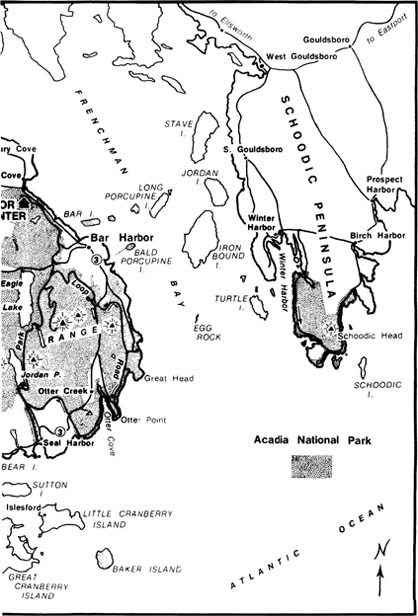

Acadia National Park
MOUNT DESERT ISLAND
Two-thirds of the way down east along the rugged coast of Maine lies a unique and special place called Mount Desert. It is the largest of the many hundreds of land fragments that rise out of the cold sea between Kittery and Eastport. The islands 108 square miles embrace some of the most varied and charming scenery of any area of comparable size in America.
Just on this single island...
 A spectacular range of glacially carved granite mountains rises boldly out of the Atlantic Ocean, seven summits of which exceed a thousand feet in elevation.
A spectacular range of glacially carved granite mountains rises boldly out of the Atlantic Ocean, seven summits of which exceed a thousand feet in elevation.
 More than a score of lakes and ponds are magnificently framed by mountains and forest, many of them filling basins that were scoured out thousands of years ago by glacial ice.
More than a score of lakes and ponds are magnificently framed by mountains and forest, many of them filling basins that were scoured out thousands of years ago by glacial ice.
 A 5-mile-long arm of the sea, Somes Sound, the only fjord on the United States Atlantic coast, slices between the mountains and nearly cuts the island in half.
A 5-mile-long arm of the sea, Somes Sound, the only fjord on the United States Atlantic coast, slices between the mountains and nearly cuts the island in half.
 Forests contain a rich blend of needled and broad-leaved trees that provide varied habitats for an abundance of wildlife.
Forests contain a rich blend of needled and broad-leaved trees that provide varied habitats for an abundance of wildlife.
 Well over a hundred kinds of wild-flowers and flowering shrubs put on a continual parade of color from April to October.
Well over a hundred kinds of wild-flowers and flowering shrubs put on a continual parade of color from April to October.
 Clear brooks flow down the mountainsides and sheltered valleys, bubbling and chattering along boulder-strewn courses and producing occasional waterfalls.
Clear brooks flow down the mountainsides and sheltered valleys, bubbling and chattering along boulder-strewn courses and producing occasional waterfalls.
 Carpets of miniature gray lichens and lush green mosses cover exposed ledges and the ground in deeply shaded spruce woods.
Carpets of miniature gray lichens and lush green mosses cover exposed ledges and the ground in deeply shaded spruce woods.
 Fragile, Arctic-like peat bogs, ringed around by slender spruces and tamaracks, offer ideal conditions for tiny rare orchids, insectivorous plants, and springy mats of water-storing sphagnum moss.
Fragile, Arctic-like peat bogs, ringed around by slender spruces and tamaracks, offer ideal conditions for tiny rare orchids, insectivorous plants, and springy mats of water-storing sphagnum moss.
 An abundance of wildlife inhabits the island, including such resident species as white-tailed deer, red fox, raccoon, and beaver; and such migratory birds as thrushes, flycatchers, and warblers.
An abundance of wildlife inhabits the island, including such resident species as white-tailed deer, red fox, raccoon, and beaver; and such migratory birds as thrushes, flycatchers, and warblers.
 Numerous coves and harbors indent the shorelinesome secluded and wild, while others that are bordered by many of the islands villages have long been safe havens for lobster-fishing boats and sailboats.
Numerous coves and harbors indent the shorelinesome secluded and wild, while others that are bordered by many of the islands villages have long been safe havens for lobster-fishing boats and sailboats.
 Widely fluctuating ocean tides along rocky shores have created a broad intertidal zone that is an ancient and primitive link between marine and terrestrial life.
Widely fluctuating ocean tides along rocky shores have created a broad intertidal zone that is an ancient and primitive link between marine and terrestrial life.
Next page

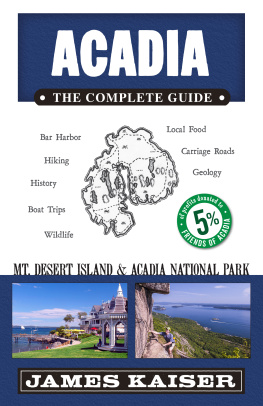
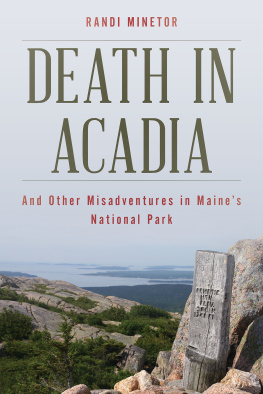
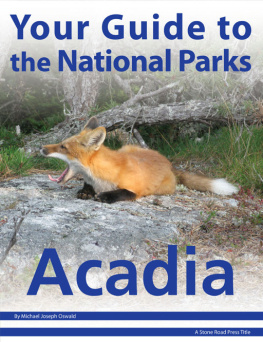
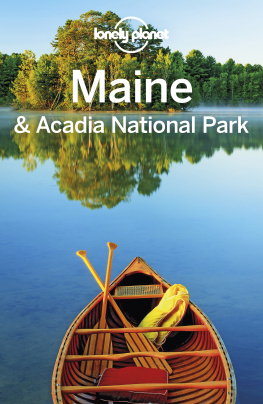
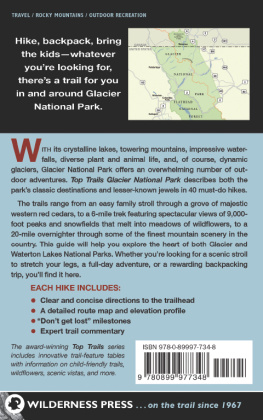


 The paper used in this publication meets the minimum requirements of American National Standard for Information SciencesPermanence of Paper for Printed Library Materials, ANSI/NISO Z39.481992.
The paper used in this publication meets the minimum requirements of American National Standard for Information SciencesPermanence of Paper for Printed Library Materials, ANSI/NISO Z39.481992.


 A spectacular range of glacially carved granite mountains rises boldly out of the Atlantic Ocean, seven summits of which exceed a thousand feet in elevation.
A spectacular range of glacially carved granite mountains rises boldly out of the Atlantic Ocean, seven summits of which exceed a thousand feet in elevation.